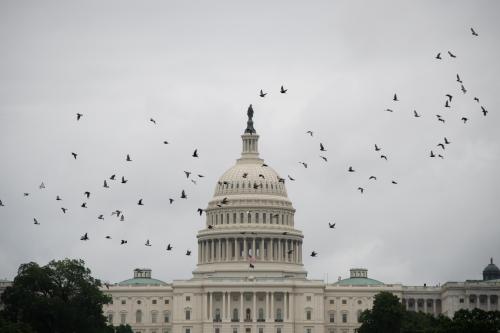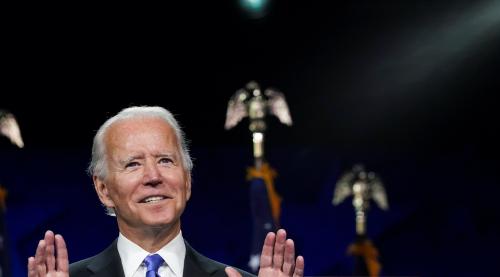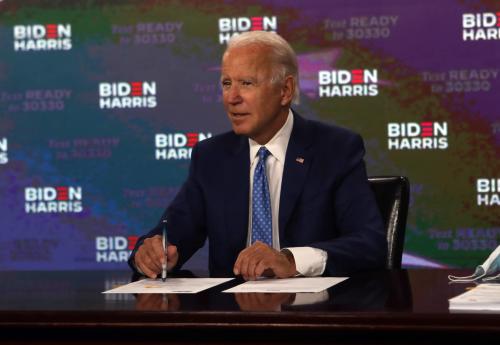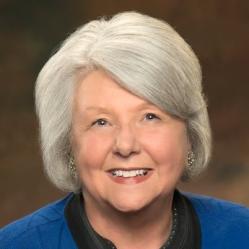In this era of COVID-19 both political parties faced an unprecedented challenge: adapting the traditional nominating convention, the basic format of which hasn’t changed much since the first in 1831, to the reality of the pandemic.
So how did they do? There was a marked contrast in their technical approach. The Democrats produced television programming that served as a convention. By contrast, the Republicans produced a traditional convention that was televised and had the feel of a theatrical production.
Democrats focused on character and compassion
In the first virtual political convention, Democrats delivered a different kind of reality show: television about real people and their upturned lives in Trump’s America, starring a guy named Joe who understands and is ready to help. Hundreds of Americans made up the cast, supported by the party’s deep leadership bench of women and people of color, past presidents and first ladies, a Pulitzer-Prize winning historian, and several well-known Republicans.
The producers, lest we miss the point, titled the program Unifying America, and with a “break the glass in case of emergency” urgency, called on viewers to vote to save democracy from a divisive president unfit to lead. At times it had the feel of a telethon (with the reminders to “text VOTE to 30330”) or the drama of a televised intervention trying to wrest the family business away from the crazy uncle who is driving it into bankruptcy.
To the surprise of many, it worked. The Washington Post suggested an Emmy nomination. Baltimore Sun media critic David Zurawik proclaimed the convention a reminder of “the enduring power of one human voice speaking passionately from the heart to a camera.” “They successfully took a 19th Century genre (the political convention) into the 21st Century media landscape,” says Kathleen Hall Jamieson, author of Eloquence in an Electronic Age and over a dozen other books on politics and presidential rhetoric. Convention speeches interrupted by applause may momentarily rally the troops, she noted in an interview, but the Democrats used more personal political persuasion. “Television invites conversational, self-disclosive intimate narrative… It allowed for others to comment live and on video to show the different dimensions of Biden: his love of family, his faith, his experience of loss. They could show that he does understand what people are going through because he has gone through it too.”
Speaking from the heart into the camera worked for standouts like Michelle Obama, who won the convention on social media, garnering five times the interactions (likes, comments, shares) of her husband at number two. It also worked for Bernie Sanders, who curtailed his bombastic style, and for Hillary Clinton, who mused ruefully from her living room that this cannot be another “shoulda, coulda, woulda” election. Jill Biden spoke from her old classroom using one of the enduring metaphors of the convention: Joe Biden can heal our broken nation just as he healed his broken family.
And for Americans cooped up for months, Democrats provided a virtual road trip in the roll call. “Magical and inspiring,” tweeted one media critic. Jamieson points out that the roll call, usually a process of showing political hacks in funny outfits on a convention floor, was “transformed into a series of vignettes that made it look like Biden was being nominated by America.”
When the narrative missed the mark, as with the 17-person keynote, the visual nonetheless relayed a party of young, diverse women and men. Some visuals did not work, as John Kasich’s long shot of a literal fork in the road or the wide shots of Kamala Harris speaking to an empty hall, which broke the intimacy of her message when talking into the camera. The moment of silence for George Floyd was awkward as the production moved from screen to screen. Julia Louis-Dreyfus’s comedy seemed off-key for a night deserving gravitas. And a few old-school politicians uncertain with the new format insisted on giving more speech than conversation and missed their opening cues.
But those were minor complaints in four nights geared to the different ways Americans consume information. This was not only good television, it was good “social television”, a concept from scholar Donatella Selva, with TV the central stage where politics happens and the use of second screens provides a social ritual of “viewing as a shared event”.[1]
Time will tell if it worked politically.
Republicans harnessed the power of the office and focused on fear
The Republican Party also was forced to bow to the pandemic even though President Trump tried to hold out as long as possible for a large in-person convention. Their solution was to televise a scaled-down, traditional convention in three cities: Charlotte, Baltimore, and Washington D.C. with the majesty of the White House and other federal sites as the stage. Not since Michael Deaver moved the first Inauguration of Ronald Reagan from the east to the west side of the Capitol, looking down the Mall to the White House and beyond to the monuments, have federal buildings been used so effectively for a televised event. The visuals were psychologically powerful, such as the Trump family launching the fireworks over the Washington monument, reinforcing the president’s acceptance speech line “We’re here and they’re not.”
This was not a Rose Garden communication strategy where the president stays above the fray and surrogates do the campaigning. This was a merging of a Rose Garden strategy with direct presidential campaigning in official settings and showcasing presidential powers like pardons. This communication advantage could forever enhance the power of the incumbency.
That power of incumbency also allowed President Trump the advantage of rebuttal and the opportunity to reframe. Just as the Democrats had warned of democracy’s demise under four more years of Trump, speakers warned you will not be safe in Joe Biden’s America. They reframed Biden as a Trojan horse of the socialist left and recast the Democrats’ message of light and darkness with mocking lines such as one about blackouts in California.
A more traditional stage and podium require adjustments in delivery for the television audience. Some speakers were better than others. Melania Trump and Ivanka Trump struck the needed conversational tone. But Jamieson believes Donald Trump, Jr’s speech and delivery were “too hot” for television and even Fox News cut away from Kimberly Guilfoyle for the same reason. “Speaking too loudly, or in the case of Rudy Giuliani, growling and seeming on the verge of being overpowered by negative emotions, defeats the purpose of the message,” she told me. In other words, you want the audience to fear the opponent, not you.
Jamieson has studied the power of fear in campaign rhetoric. “To the extent you are fearful, you are more likely to vote for the person who will reduce that fear.” There were repeated references to President Trump as protector of America from cancel culture, riots in the suburbs, and socialism. The president’s conflating of Black Lives Matter’s peaceful protestors with rioters, looters, and anarchists may be working. Support for BLM has decreased thirteen points in the battleground state of Wisconsin in last two months.
As for Trump’s speech itself, Jamieson believes he did what he needed to do. Some called it flat. But a bombastic rally-style speech would not have worked, and while the speech itself was poorly organized, he stuck to the teleprompter and avoided being too hot for television.
Social media and the second screen as a convention hall
Each of the conventions got roughly 50 million social media interactions. First Ladies Michelle Obama and Melania Trump won their conventions with Mrs. Obama at 7.6 million interactions and 3.1 million for Mrs. Trump. The GOP had the benefit of President Trump retweeting every convention speaker to his 85 million followers. Both parties leveraged the power of local media. The Republicans provided download-ready B-roll to local stations, still an important source of voters’ news. Democrats pitched local stories on the Americans whose videos were chosen from the party’s crowdsourcing effort.
Two starkly different versions of reality were on-screen
Finally, let’s return to the visuals. Michael Deaver, known as former President Ronald Reagan’s vicar of visuals, knew that in television what you see trumps what you say. These conventions reflected two different pandemic realities: a Biden reality and a Trump reality. Visuals of masked Democrats socially distancing and talking to each other through Zoom in a mostly virtual convention vs. visuals of crowds in Charlotte, Fort McHenry and the White House south lawn, with few masks on an audience sitting close together. The visual contrast was stark—the pandemic still raging or the pandemic controlled and in the past tense. The visuals also presented two different realities of the movement for racial justice: riots in the streets of cities with Democratic mayors vs. peaceful protests in those same cities. And finally, the visuals showed two different realities of the economy: people thriving in a recovering economy vs. people without jobs and food, insecure in an economy brought down by bungled handling of COVID.
But the reality that matters the most is the reality of the individual’s life. Campaign rhetoric may be mediated through the network a person watches, but more important is their own reality. And it is the reality voters live every day that will decide the next president on Election Day.
[1] Selva, Donatella. 2016. “Social Television: Audience and Political Engagement.” Television and New Media 17, no. 2: 159–73.







Commentary
Did the first virtual conventions succeed?
September 2, 2020